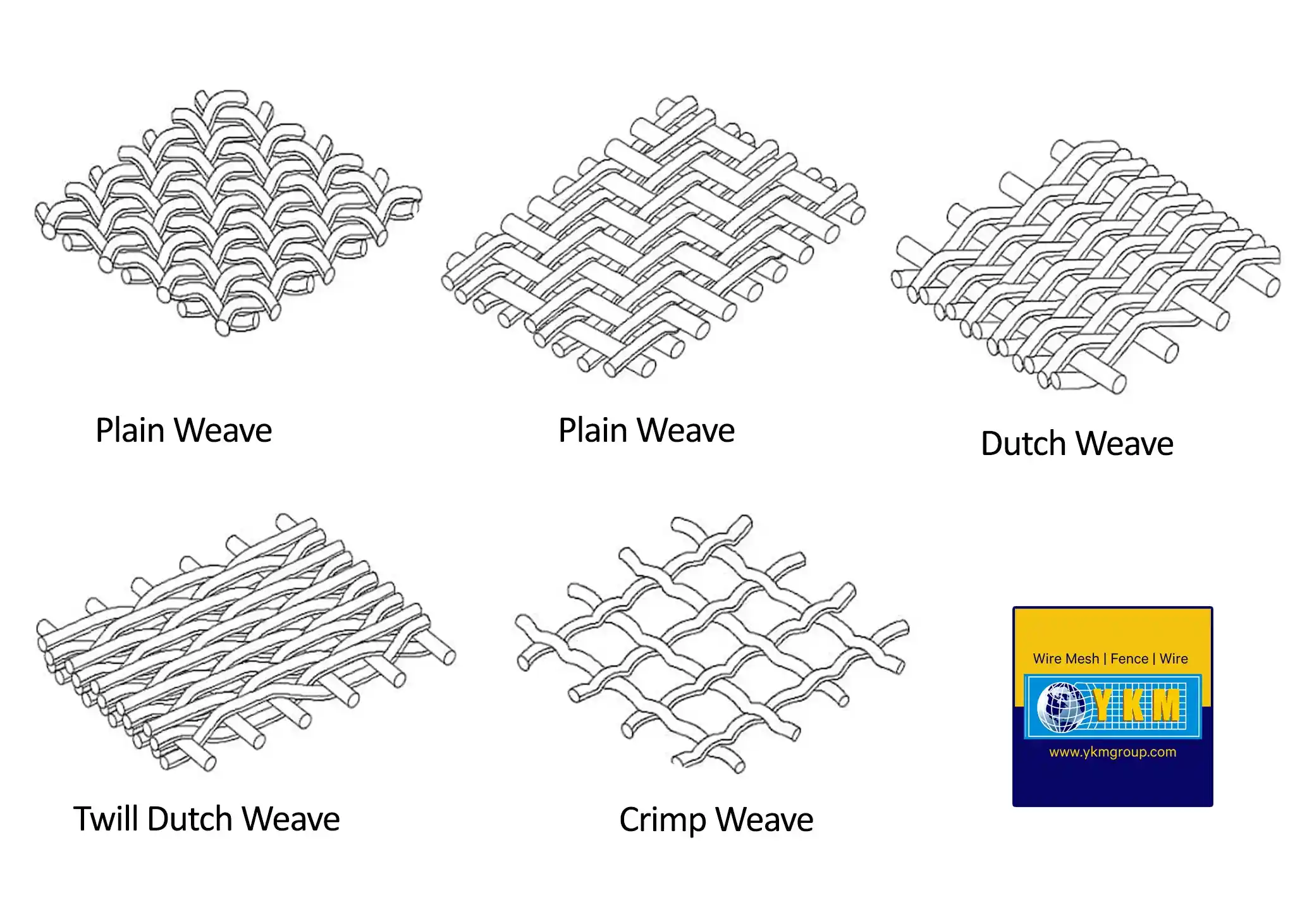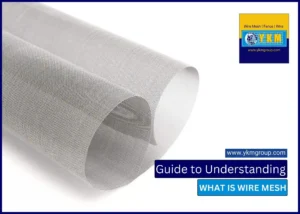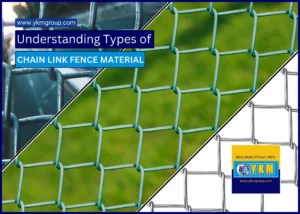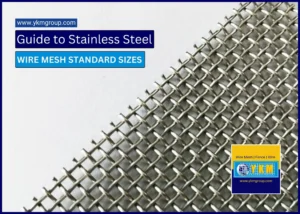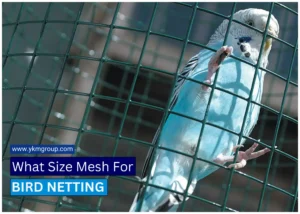Woven Wire Mesh Weave Patterns are the often underappreciated heroes of industrial filtration screens & modern construction and design industry. They have their vital role as filter screens as well as in construction and design industry. In this extensive article, we will delve deep into the captivating world of Woven Wire Mesh Weave Patterns, exploring their intricacies, applications, and much more.
The Art of Weaving: Woven Wire Mesh Weave Patterns Explained
Woven Wire Mesh Weave Patterns involve a meticulous interlocking of wires to create a grid-like structure. This artful process results in various patterns that are not only visually appealing but also serve a multitude of purposes in different industries. Let’s delve deeper into the intricacies of these patterns.
Plain Weave

If you’re looking for simplicity and uniformity in wire mesh patterns, Plain Weave is the way to go. This pattern involves wire mesh woven in a straightforward over-and-under pattern, resulting in a tight and regular mesh. Its primary characteristics are uniformity and simplicity, making it ideal for applications where consistency is key. Filtration and separation processes, where a precise and evenly spaced mesh is required, greatly benefit from Plain Weave.
Twill Weave
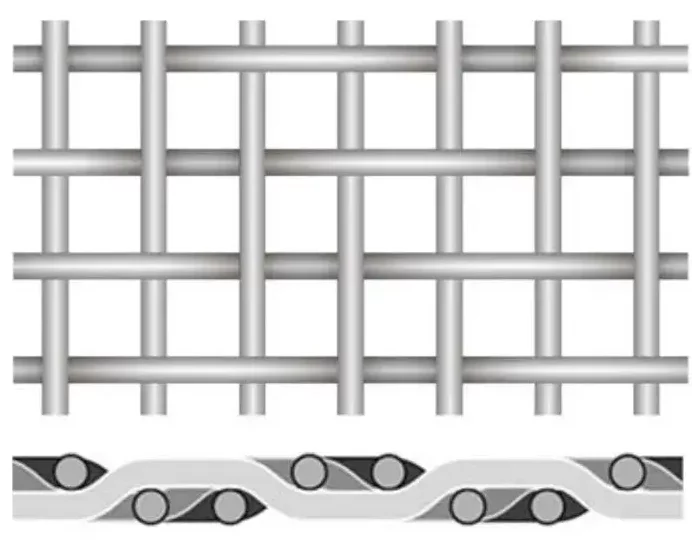
Twill Weave is one of the most common and versatile Woven Wire Mesh Weave Patterns. In this pattern, wires are interwoven over and under each other, creating a distinctive diagonal appearance. The unique diagonal structure provides the pattern with exceptional strength and flexibility, making it suitable for a wide range of applications. Whether you’re reinforcing concrete structures in construction or designing intricate details in architectural elements, Twill Weave offers a balance of aesthetics and function.
Dutch Weave
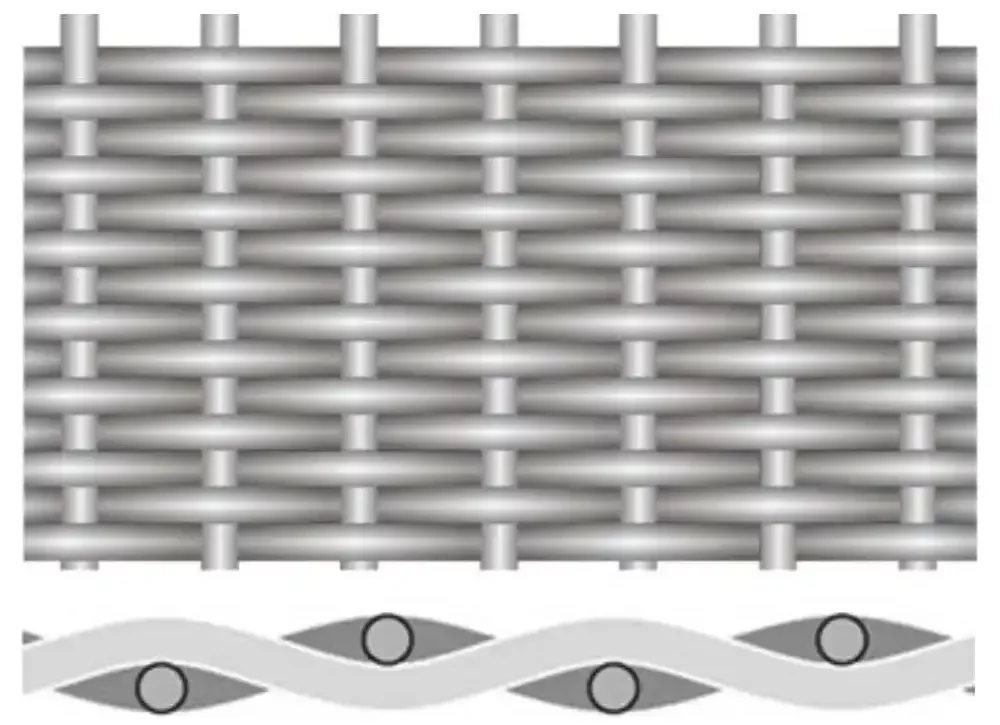
Dutch Weave, on the other hand, is renowned for its exceptional strength and fine filtration capabilities. In this pattern, a thicker warp wire is interwoven with a thinner weft wire, resulting in a tight and dense mesh. Dutch Weave excels in applications where fine filtration and high tensile strength are essential. Industries such as oil and gas rely on Dutch Weave for effective filtration processes.
Twilled Dutch Weave

Twilled Dutch Weave is a remarkable combination of the features of Twill Weave and Dutch Weave. This pattern features a diagonal structure similar to Twill Weave, but it also offers the fine filtration capabilities of Dutch Weave. It’s the perfect choice for applications where both strength and precision filtration are required. In the aerospace industry, for instance, Twilled Dutch Weave is used for filter screens in aircraft, ensuring the reliability and performance of critical systems.
Crimp Weave
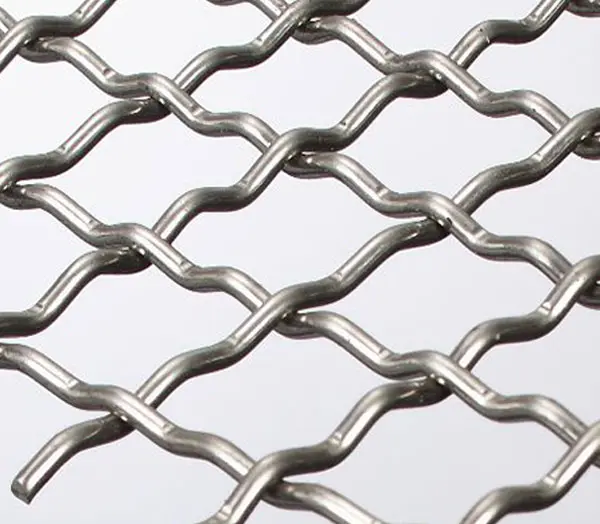
Crimp mesh weave is a versatile and highly adaptable technique used in the manufacturing of wire mesh screens and filters. The distinctive feature of crimp mesh weave is its pattern of crimped or wavy wires, which interlock to create a sturdy and durable mesh structure. This weaving method enhances the mesh’s structural integrity, making it ideal for applications where strength and stability are paramount, such as in the construction of security screens, industrial sieves, and architectural elements.
One of the significant advantages of crimp mesh weave is its ability to provide various opening sizes, wire diameters, and patterns, allowing for customization to suit specific requirements. This flexibility makes it a popular choice in industries ranging from agriculture to mining, as well as in architectural and decorative applications. Whether it’s filtering particles, reinforcing concrete, or adding a distinctive aesthetic touch to a building’s façade, crimp mesh weave proves itself as a versatile and indispensable solution that combines form and function with remarkable efficiency.
Applications in Various Industries
The beauty of Woven Wire Mesh Weave Patterns lies in their versatility and adaptability across various industries. Let’s explore how these patterns play critical roles in different sectors:
Construction
In the construction industry, the strength and durability of structures are of paramount importance. Woven Wire Mesh Weave Patterns play a pivotal role in reinforcing concrete structures. They ensure that buildings and infrastructure can withstand the test of time. Twill Weave and Twilled Dutch Weave are often preferred for their balance of strength and flexibility, making them ideal choices for structural reinforcement.
Agriculture
For farmers and agricultural applications, safety and containment are top priorities. Woven Wire Mesh Weave Patterns are essential for creating fencing and animal enclosures. They ensure that livestock is securely contained while allowing farmers to maintain a clear view of their animals. These patterns provide a sturdy and reliable solution for safeguarding farm animals.
Aerospace
The aerospace industry demands precision, reliability, and safety. Woven Wire Mesh Weave Patterns meet these requirements seamlessly. Filter screens in aircraft are crucial for the smooth operation of engines and systems. Twilled Dutch Weave’s combination of strength and fine filtration makes it an ideal choice for ensuring the performance and longevity of aviation components.
Architecture
Architecture is a realm where aesthetics and structural support go hand in hand. Woven Wire Mesh Weave Patterns are appreciated for their decorative façades and interior designs. They offer architects the opportunity to incorporate artistic elements into their creations. Whether it’s designing an intricate mesh screen or a visually stunning façade, these patterns offer endless possibilities.
Chemical
In the chemical and petrochemical industries, product quality and safety are non-negotiable. The woven pattern of Stainless Steel Wire Mesh find their place in filtration processes. They ensure that chemicals and petrochemicals are free from impurities. Dutch Weave, with its fine filtration capabilities, is often the pattern of choice, guaranteeing the integrity of the end products.
Food Processing
Food safety and quality control are paramount in the food processing industry. Woven Wire Mesh Weave Patterns are used in the form of strainers and filters. These patterns effectively remove impurities and contaminants from food products, ensuring that consumers receive safe and high-quality food items.
Automotive
The automotive industry relies on precise and efficient engine filtration systems to maintain the performance and longevity of vehicle engines. Woven Wire Mesh Weave Patterns are used in these filtration systems to ensure that engines operate smoothly and remain free from impurities. This application is critical for maintaining the reliability and longevity of vehicles.
Conclusion
Woven Wire Mesh Weave Patterns are not just functional; they are a work of art in their own right. Woven Wire Mesh Weave Patterns are versatile, durable, and aesthetically pleasing. Their impact spans a multitude of industries, and the intricate weaves continue to fascinate architects, engineers, and designers alike. The next time you encounter an impressive architectural design or a reliable filtration system, take a moment to appreciate the subtle beauty of Woven Wire Mesh Weave Patterns.
FAQs (Frequently Asked Questions)
-
What are the key characteristics of Woven Wire Mesh Weave Patterns?
Woven Wire Mesh Weave Patterns are characterized by their strength, flexibility, and filtration capabilities. They offer a balance of functionality and aesthetics, making them versatile for a wide range of applications.
-
Which industries benefit from Woven Wire Mesh Weave Patterns?
Industries such as construction, agriculture, aerospace, architecture, chemical, food processing, and automotive rely on Woven Wire Mesh Weave Patterns for various applications due to their adaptability and reliability.
-
What is the difference between Twill Weave and Dutch Weave?
Twill Weave features a diagonal pattern, while Dutch Weave combines thicker warp wires with thinner weft wires for fine filtration. The choice between the two depends on the specific requirements of the application.
-
How do Woven Wire Mesh Weave Patterns enhance architectural designs?
Woven Wire Mesh Weave Patterns provide a unique, decorative element in architectural designs. They offer both aesthetics and structural support, allowing architects to create visually stunning and structurally sound elements.
-
Are Woven Wire Mesh Weave Patterns suitable for industrial filtration?
Yes, patterns like Dutch Weave and Twilled Dutch Weave are exceptionally well-suited for precise and demanding filtration needs. Their fine filtration capabilities make them ideal for applications in industries such as chemical, petrochemical, and aerospace.
-
Can Woven Wire Mesh Weave Patterns be customized for specific requirements?
Absolutely! These patterns can be tailored to meet specific strength, size, and filtration needs. Customization ensures that the wire mesh meets the exact specifications of the intended application.
